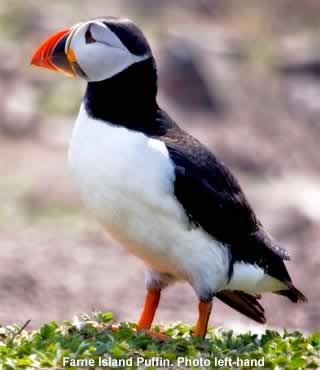The Farne Islands |
|
 |
|||
Britain > Northumberland > Farne Islands |
A collection of islands located around 3 miles off the coast of Northumberland, famous for its seabirds |
The Farne Islands are located around 3 miles (5km) off the coast of Northumberland. It's hard to say how many of them there actually are, as some become completely submerged at high tide. Only 15 of them are visible at all times, but when the tide drops down again, up to 13 more are revealed. |
The Farnes are well known as being one of the most important breeding sites for European seabirds. The high season in May and June sees 100,000 feathered couples making their way here, including terns, guillemots, and the ever-popular puffins. There's nowhere else in the UK that you can see so many different seabirds in the same place. |
Boat trips to see the wildlife are very popular, and the birds don't seem to mind being gawked at. Actually, some of the terns have even been known to grow a bit curious themselves, and swoop in for a closer look! It's probably a good idea to wear a hat, as their beaks can be quite sharp. |
On many of the islands, visitors are completely forbidden. This is with the exception of the official wardens of the National Trust, who take good care of the place. However, as many of the birds make their homes on the rock faces of the cliffs, the deck of a boat can provide a much better view than anywhere else. |
Nevertheless, those with a craving to step onto one of the Farne Islands can do so, on both Staple Island, and Inner Farne. The former is a wild, rocky outcrop, perfect for the more adventurous visitor. The latter island, Inner Farne, is the biggest in the group. It's famous for its association with St. Cuthbert, an important Christian figure from the 7th century AD. After giving nearly a lifetime in service to the church, he decided to retreat to Inner Farne, to live alone in solitude with God. After his death, many people followed in his footsteps, and came to live a quiet life on the island. A small church called St. Cuthbert's Chapel was set up in his honour, which is still standing today. |
Inner Farne is the best equipped of the islands, with a visitor centre, and wooden boardwalks. There is an old Victorian lighthouse, which is still in use. It's one of several lighthouses on and around the Farne archipelago. The most famous is the Longstone Lighthouse, which was the setting of the Farnes' most famous story. In the early 19th century, Longstone was occupied by its lighthouse keeper, and his child, a young lady by the name of Grace Darling. Early one morning, she was gazing out to sea, when she spotted a huge ship, the SS Forfarshire, which had been wrecked in the night. She quickly called her father, and together they rowed out to the ship. They rescued everyone they could, at huge personal risk. Since that day, Grace's story has been passed on, generation to generation, so that it should never be forgotten. |
The water around the Farne Islands may often become rough and dangerous for boats, but it makes a perfect home for the archipelago's other group of residents. As well as seabirds, the area is also a breeding ground for seals. Between 3 and 4 thousand of them come every year, which produce several hundred new pups. The seals are the largest species of carnivore that live in the UK, but if this doesn't put you off, then you can take a closer look by getting into the water yourself. The Farnes are a popular location for scuba diving, with several shipwrecks to explore. As you look round, be prepared to make some new friends, as the seals are often keen to meet their strange new companions! |
|
Pocket Britain is optimised for use on a smartphone or tablet with internet access. All content is subject to copyright. All reasonable methods have been used to ensure information supplied is accurate at the time of publication. However, it is advisable to check information before relying on it. Privacy Policy |